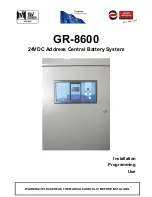
Date
26/6/2017
Document 923860006_09_006
Document code 923860006_09_006
Page 6 from 44
2.
Installation
This section contains information that concerns the designing of the installation, the connection of the panel with
the luminaries and the use of the auxiliary outputs and inputs. The instructions must be read carefully by the
installer that is set to commission the panel. Skill and knowledge about the panel as well as its peripherals is
essential for the good operation of the installation.
All the connections described below must be done with the 230VAC mains power supply isolated and the
battery fuse removed.
2.1 Designing the installation
Before starting to install the cable you must take into account some critical parameters.
- Each luminary installed in any zone can be programmed individually to operate in maintained or non-
maintained mode.
- Each luminary in a zone should get a unique address. If 2 or more luminary are installed with the same
address in a single zone, there will be a data collision and the specific point (address) will not function
properly.
- There is an option for wall mounting the panel with the correct accessories. Please refer to manufacturer
for further information for wall mounting.
2.2 Choosing the correct cable
The cable between the panel and the luminaries must have the following specifications:
2-core twisted pair cable. Normally the cables are unshielded but if the cable passes near
noisy/industrial environment the cables must be shielded.
The cable must have only 2 cores, no other cables. If the environment is too noisy (motors, industrial
etc) a cable with shield must be used.
The cable must have low resistance, below 25 Ohm/km. The total impedance of the cable of each core
from start to finish must be more than 9 Ohm or the maximum voltage drop 3,5V.
The capacitance of the cable must be low (below 200pF/m). The total capacitance of the whole
installation must not exceed 800nF.
The cable that will be used must be resistant to fire for at least 90 minutes.
The cable cross section depends on the consumption of the luminaries on the zone and the total
length. It can be calculated using the table below. The table shows the required cross section of the
cable depending on the length and the consumption.
Typical cable cross section is from 1mm
2
to 4mm
2
depending on the number of connected luminaires,
topology of the installation and length of cable runs.





















